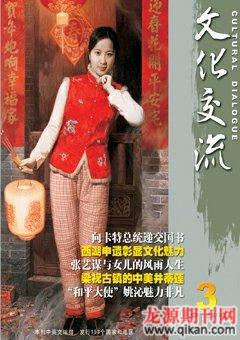A Pioneer of Modern Dance in China
Bao Zhicheng, our special reporter

Jin Xing sits opposite, dressed in a black brocade Chinese jacket. On the cuffs is the ornate decoration in a riot of gold, orange, red and blue, which sets off her purple fingernails and a large-size purple ring. Her elegant manners, charming eyes, intelligence in her remarks, and avant-garde views make her so aesthetic and poetic and so real.
Today, Jin Xing enjoys national and international renown for her pioneering role in introducing modern dance to China and promoting it successfully. Beside her much acclaimed accomplishment in her preeminent career, Jin Xing is also known as a transwoman. Born as a male in northeast China, Jin Xing was a member of the military troupe and received solid training in traditional and classical dance and ballet before he went on to a military academy of arts in Beijing. In 1988, he went to New York under a government cultural program and studied modern dance in the Big Apple. The study changed his life forever. After America, he went to Europe to further his training in dance and choreography. In 1995, he took a sex reassignment surgery and became a woman. In 1996, she came back to Beijing, thus starting her career of promoting modern dance in her motherland.
As art director of Beijing Modern Dance Troupe, Jin Xing tried to introduce modern dance in its full glory to the oriental country. In west, a dance troupe would not survive if it lacks modern elements. But at that time audiences in China knew almost nothing about modern dance. Some even regarded it as taboo. Even though Jin Xing won many top honors for her unusual dancing achievements, she keenly felt restrictions. So in 1998 she set up her own business: Jin Xing Modern Dance Troupe, which is still the only private professional modern dance troupe in the country so far. In order to find a better ambiance for further growth, she moved to Shanghai. Although at first Shanghai did not look very promising in all aspects, she believed the citys metropolitan mentality and tradition were most suitable for modern dance.

It is in Shanghai that the inspired Jin Xing created some of her best numbers. “Shanghai Tango”, one of her masterpieces based on “Thunder Storm”, a pioneering and milestone modern Chinese drama written by Cao Yu in his early 20s, is her first major success. She dramatized the heroine in western body language and chosen tango music to highlight her interpretation. The relationships of a woman with her husband, her past lover and her son were perfectly portrayed. The “Charms of Shanghai”, another of her masterpieces, gives audiences an opportunity to see a 5-minute film at the beginning of the show. The clip shows how Jin Xings beautiful face gets all the cosmetic touches in a style of the Tang Dynasty by a makeup assistant and then she is seen getting dressed up in glorious costumes. While the 5-minute video is unfolding, 15 dancers dressed in Chinese tunic suit dance in the foreground. Then Jin Xing as Lady Yang, a legendary concubine of a Tang emperor, comes onto the stage, fully dressed with only her face not covered. Jin explains the total costume strategy: human beauty in the Chinese aesthetics lies in the face, not in the body and that is a big difference between the Chinese and western aesthetics.
The “Charms of Shanghai” was originally created by two German artists. Jin Xing re-choreographed it and chose a piece of Bach for music. It was designed as an essential Chinese work for westerners. Some moves are so Chinese that they remind Chinese audiences of some traditional Chinese dances. Jin Xing comments that these dances reflect her aesthetic experience and memory.
According to Jin, plots and costumes in modern dance are relatively simple, body language is somewhat exaggerating and powerful to express psyche, emotion and personality, and it is designed to sing of the good, the beauty and the true of humanity. Audiences find it easy to understand when Chinese classics and western modern dance are perfectly merged in an overwhelming performance.
To keep her troupe with 20 plus performers alive and flourishing, Jin Xing needs to make profit. As her troupe is successful, she gives back generously to the society. “Dance in Shanghai”, a project she proposed and supported with a fund of 3.5 million yuan out of her own pocket, is one of the things she has done for Shanghai.
Now in her forties, she has a dream for future: she wants to appear in drama and film and promote her original modern dance to the world. She emphasizes that her roots are in the 5,000-year-old Chinese civilization and that she gets her inspiration from the glorious Chinese culture. In her eye, the cosmopolitan Shanghai is ideal for her art and her home. Today, she lives with her husband and three adopted children in Shanghai. She says that children play an important part in her life, testified by the fact that one of her dancing stunts was inspired by her three children. □

